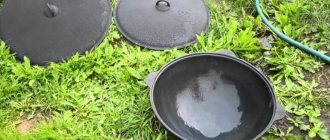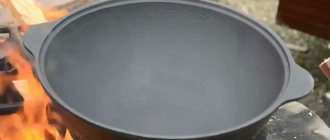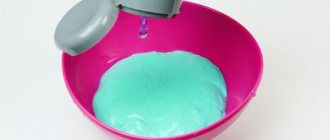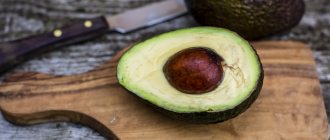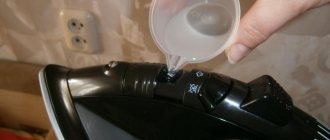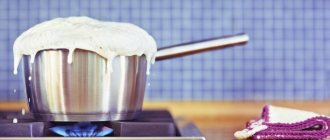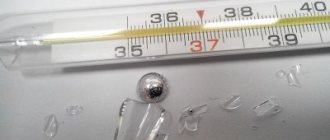Various books on home economics describe many methods for cleaning kitchen utensils, but not all of them are suitable for cast iron cauldrons. Despite its “brutality,” it is a very capricious metal and requires delicate handling. For example, cast iron cookware cannot be cleaned with abrasive agents and dropped - it will crack. From this article you will learn whether a cast iron cauldron rusts, what to do in this case and how to store it correctly.
Causes of contamination of cauldrons
There are a number of reasons why the walls of cauldrons become covered with rust. They all stem from one common problem: improper care. The structure of the cauldron is very porous, so if it is not properly cared for after washing, it can deteriorate. Cleaned dishes from food residues must be wiped dry so that moisture does not accumulate in the pores and the destruction of the walls does not begin.
The cast iron alloy contains iron, which requires a certain approach. Before you start using a cast iron cauldron, you need to heat it well. In such situations, you can use vegetable oil, salt, sand and many other methods. If the first treatment is carried out correctly, then rust will not occur on cast iron cauldrons.
Why does rust appear?
If your cast iron cauldron is rusty, this does not mean that you received a defective product.
The reason for the appearance of rust lies in the chemical structure of cast iron, namely the content of a large amount of iron. With prolonged contact with liquids and acids contained in food, iron can rust. Red spots appear on the surface of the dishes. They not only spoil the appearance of the product, but also worsen the taste of the food. If a cast iron cauldron is rusty, it is prohibited to cook food in it - you will have to make every effort to remove traces of corrosion. Often rust occurs due to the fault of the owners themselves:
- the cauldron is processed in the dishwasher;
- use aggressive household products for cleaning;
- soak for a long time to remove burnt food residues;
- stored in a room with high humidity;
- Do not wipe immediately after washing, leaving the cauldron to dry on its own.
Another reason why a cast iron cauldron rusts from the inside is improper preparation of the cookware for use. More precisely, the complete absence of this preparation. A cast iron cauldron is a special product; it cannot be used immediately after purchase. First, the cauldron needs to be calcined to remove industrial grease, and then the walls must be well “oiled.” Vegetable oil will create a thin film that will prevent food from burning and the cauldron from rusting.
Important! Do not neglect the calcination procedure - this prolongs the life of the cast iron cauldron.
How to clean a cast iron cauldron?
They cook pilaf over a fire, which leaves dirt and soot on the cauldron - the causes of corrosion. Damaged dishes oxidize, rust gets into the food and causes poisoning. Regular cleaning can prevent this from happening.
Soap and glue
At home, laundry soap and regular office glue will do a great job of removing carbon deposits. This product guarantees the integrity of the walls of the cauldron and the invariability of the taste of the food cooked in it. The step-by-step procedure looks like this:
- The dishes are treated with detergent.
- Then they are immersed in a bucket.
- Prepare a slurry of laundry soap (72%) and glue, a bar of the former and 100 grams of the latter.
- Place the bucket on the fire and fill it halfway with water, bring to a boil. The mixture of soap and glue is dissolved, mixed and the cauldron is immersed in it, boiled in this form for 2-3 hours.
- Then intensively clean the dishes with a sponge or brush.
We must not forget about the toxicity of glue vapors; we must protect the respiratory tract and skin. Good ventilation and gloves on your hands will not hurt.
Salt, vinegar and soda
You will need:
- table salt – 2-3 tbsp. l.;
- concentrated vinegar (75%) – 2-3 tbsp. l., or table - half a glass;
- soda – 2-3 tbsp. l.
Steps:
- fill the cauldron with salt, top with a layer of vinegar;
- heat the mixture and add soda to it;
- stir, add water and boil for about an hour;
- Cool the cauldron and rinse with Fairy or other means (AOC, Pemolux, Mister Muscle).
Salt and soda
- Fill the cauldron with water to the top, add 200 g of salt and soda;
- boil, stirring, then simmer over low heat for about 2 hours;
- cool and rinse;
- You can also boil it with citric acid in a ratio of 2 tablespoons per liter.
Sand
This material is a natural abrasive. Usually the cauldron is cleaned with it while camping; it helps remove soot, tar and even mold. Step-by-step instruction:
- Fill the bowl to the top with sand;
- hang over a smoldering fire for 10 hours;
- then simply pour out the sand and rinse the cauldron.
From rust
To clean a cauldron from rust, you need to put in much more effort than when removing regular carbon deposits. First, you should try household chemicals (for example, Cillit), as a rule, they at least partially help. After this, you can rub the cauldron with sandpaper or metal shavings, and preferably more than once. Abrasive can be of several types: large and fine. The first removes the main layer of rust, the second cleans micropores.
A drill with a flat attachment works much more efficiently. It requires less effort and energy, and produces better results. Another option is to use a more modern sander. It costs her nothing to remove a layer of rust in a few minutes. But here you need not just golden hands, but professional skills. One awkward movement can ruin the dishes, so you should trust this procedure only to a locksmith or a man who understands it. In a few minutes, they will return the cauldron to the owner like new, sparkling and shiny.
The following can help you deal with rust at home:
- For slight contamination - detergents with abrasive particles and a steel wool, half a potato (which just needs to be wiped off the surface).
- If there is a large layer of rust, boil it down; to do this, take a bucket, fill it with water and immerse the cauldron in it. Add salt (1 pack per 6 liters). Place on low heat and cook for 7-8 hours.
Caring for a cast iron cauldron
The cauldron, cleaned of rust, scale and soot, must be calcined and cooled, lubricated with vegetable oil inside and out. It creates a protective layer on the surface of the dishes, making them shine beautifully. Only after processing is the cauldron put back in place.
There are several conditions required for caring for cast iron cookware:
- Wash immediately after cooking.
- For minor stains, do not use metal shavings or strong chemicals.
- Do not put the cauldron in the dishwasher (temperature removes the protective layer).
- After washing, wipe dry.
- Store in a dry place.
Corrosion Prevention
Removing rust is a troublesome and difficult task. Therefore, prevention is a priority. As we have already said, after washing, you need to immediately heat the cauldron, and then lubricate the outside and inside with oil. This must be done every time after cooking. Another tip - before cooking pilaf for the first time, you need to treat the dishes in the same way. If there is a lid, it is also calcined and lubricated.
The first treatment is carried out in the oven, heated to 200 degrees, or on the stove, with salt at the bottom of a cauldron (2 kg). When it darkens, you can remove the dishes from the heat.
Correct calcination
Calcination and cleaning with salt is not recommended for use at home in the kitchen or indoors in general. Hot oil and salt can lead to burns, damage to furniture, fire, and acrid smoke will permeate your entire apartment.
It would be correct to transfer these procedures to the open air.
Let's clean it first
Cast iron has a porous surface and you will not be able to wash such dishes clean. Rust in hard-to-reach pores adds complexity. It will not allow a film to form in this place. We need to find a way to clean it properly.
Traditionally, cast iron cauldrons are cleaned with salt.
So, you already have a washed cauldron, there is a fireplace for the cauldron, firewood, 1-2 kg of table salt per 10 liters of cauldron volume and a convenient iron slotted spoon.
The process is slow and will take 2 hours of your time.
Let's get started:
- Place salt in a cold cauldron.
- Light a fire.
- Keep the heat below medium. Stir the salt occasionally.
- When the salt turns light brown, remove the heat from under the cauldron and let the cauldron and the salt cool.
- Salt is good for nothing after cleaning - throw it away.
- The surface of the cauldron is cleaned with dry paper towels or dry napkins.
Protect your skin and eyes from hot salt.
Now the surface is cleaned and has no protection. You need to immediately proceed to firing, otherwise the dishes will quickly rust.
Firing in oil
Firing a cauldron with oil is sometimes called “blueing,” but this is incorrect. No iron oxides are formed here and a smooth film of oil burnt to the cast iron is created.
Don’t be alarmed by what’s burnt: you won’t notice it in the dish.
For roasting, either vegetable oil (sesame, flaxseed, sunflower) or animal fat (pork, beef or lamb) is used.
You will need 0.1-0.3 liters of oil per 10 liters of cauldron volume. A fireplace for the cauldron, some firewood and the right slotted spoon will also be required.
Let's start forming the film:
The firing itself will take 20-30 minutes. And will require your active participation
- The cauldron should be dry inside. Be sure to check and, if necessary, dry with paper towels or dry wipes.
- Pour oil into a cold cauldron.
- Light a fire. The heat should be medium.
- Using a slotted spoon or tilting the cauldron, coat the entire inside surface with oil. Important: Try not to splash oil on the fire.
- Keep an eye on the walls and periodically pour oil on them when they seem to be drying out. I see.
- After calcination is complete, drain the oil. It needs to be thrown away.
- Let the cauldron cool, remove it from the heat.
- Wipe the surface of the cauldron with paper towels to absorb all unnecessary oil.
In a wiped-clean cauldron, the first thing to do is boil water. If the water does not turn out cloudy, the dishes can be safely used for dishes.
How to bake in the kitchen
We have an extremely negative attitude towards carrying out these procedures at home.
This is due to a nasty smell throughout the entire apartment, a fire hazard, and the threat of burns.
We believe there is no reason to justify firing cast iron cookware in an apartment.
But if you are determined, we have some tips on how to reduce the harm:
- Open all windows. A draft will only be a plus.
- When cleaning, use one-third less salt, but stir more often.
- When firing on a burner, add salt to the oil 1:1, this will reduce smoke.
- Use the oven to bake. More on this below.
If you bake in the oven:
- Heat the oven to 180-200 degrees.
- Pour 10-25 grams of oil into a cast iron pan. Apply oil with a brush to the entire inner surface.
- Cover the top of the dish with foil. This will keep your oven free of oil.
- The dishes are kept for 40 minutes - 1.5 hours.
- It will take 3-5 approaches. Applying oil and keeping in a preheated oven.
Prevention of corrosion and care of a cast iron cauldron
Any utensils need careful and responsible handling. If, after cooking, the cauldron was not washed well, not wiped dry and put in a cupboard, then it is not surprising that rust will soon appear in it.
Do not store the cauldron in a damp place. After washing, the utensils must be thoroughly dried and only then put away for storage.
To prevent this from happening, you must follow a number of rules:
- Before the very first use, the cauldron is heated. This makes it stronger, food will not stick to the walls, and it will be easier to clean.
- After washing the cauldron, you should dry it well with a soft cotton towel, and leave it in the open air for a while to ventilate and dry better.
- Important: the boiler must be cleaned immediately after cooking. Then you won’t have to deal with dried-on food residues and spoil the surface with harsh shuffles.
- Do not use aggressive agents or steel wool: they destroy the non-stick layer. An ordinary kitchen sponge and odorless liquid soap are sufficient for effective care.
- It is not recommended to pay attention to advertised anti-rust products. All of them contain harmful substances that only worsen the situation. It is much better to use “grandmother’s” remedies.
- Just emerging, barely noticeable rusty spots can be easily removed with the juice of an onion or raw potato.
Features of cleaning cauldrons made of different materials
The cauldron can be made of various metals. In order for the dishes to last a long time, it is worth considering the properties of each material when using and cleaning.
Cast iron
The most popular and wear-resistant material. Absorbs oil, due to which a protective non-stick film is formed on the surface. After the first calcination, you cannot use chemicals or hard sponges, otherwise you will have to create a natural non-stick layer again. If the container has an enamel coating, it should not be overheated, otherwise the enamel will be damaged.
Aluminum and duralumin
Aluminum cauldrons have thinner walls, so they do not tolerate exposure to abrasive substances and rough sponges. In addition, such actions usually lead to damage to the non-stick coating.
Copper
Such dishes are now practically not used, due to the peculiar cleaning methods. Copper containers are most often used in traditional Central Asian cuisine.
Non-stick coating
Such dishes are made of stainless steel and coated with a special coating that prevents food from burning. Under no circumstances should cauldrons with a non-stick coating be calcined or washed with abrasives, hard brushes or metal sponges.
How to protect a cast iron cauldron from rust
Unfortunately, no matter how a cast iron cauldron is cleaned, it will rust (unless, of course, it is covered with a special protective layer on top). To prevent cast iron from rusting during storage, it is necessary to exclude its contact with air. To do this, you can simply grease the dishes with a thin layer of vegetable oil.
To protect cast iron more reliably and for a long time, you can bake the pores. To do this, the cauldron is thoroughly greased with a thick layer of oil or fat and baked upside down in the oven, after which it is washed. Burnt oil is safe for humans and reliably seals the pores of the metal from oxygen and moisture.
Is it possible to cook in a rusty pan?
Another question is that the dishes are damaged, so rust appears. Then you should not use such dishes. Rust and other manifestations when heating damaged cookware are also harmful. If we have problematic dishes, they migrate to animals (chickens, ducks).
Interesting materials:
Who was the coward and the tail in the Italian Commedia dell'Arte? Who is the marshal in Russia? Who produces bicycles in Ukraine? Who was part of the mighty group? Who is part of the Boyar Duma? Who is included in the Zemsky Sobor? Who ate the forbidden fruit? Who owns Xiaomi? Who lives in the Sahara Desert? Who fought on the side of Germany?
Proper storage
To ensure that the cauldron is always clean and does not succumb to corrosion, it must be stored correctly. To do this, after the cauldron is cleaned, wipe it dry. It is better to leave it in the fresh air for a short time so that it ventilates and dries completely. It must be stored in a spacious, dry, closed cabinet so that dust and moisture do not penetrate there. It is best to keep the cast iron lid separate so that it does not damage the coating and do not place other kitchen utensils inside so that water does not leak from them and they do not scratch the surface.
Rust removal
To clean a cauldron from rust, you will have to put in a lot of effort and time. You need to understand that the surface becomes covered with a red coating when the dishes are not stored correctly. Always wipe down pots before storing them and keep the storage area free of moisture.
Aluminum cauldrons are more susceptible to rust than cast iron ones
Before processing, it is correct to soak the dishes in a solution of vinegar and water (1:1 ratio). Next, use a metal brush to carefully scrape off the plaque. To remove rust manually, you will have to spend a lot of time, so experienced housewives prefer to use improvised means:
- sandpaper with medium and coarse grit;
- grinding apparatus;
- drill with a special attachment.
When using sandpaper, use coarse-grained paper first, and medium-grained sandpaper at the end, processing the plaque with them in turn. Before washing dishes, apply a special rust-corroding agent, following the instructions for use.
Preventive actions to prevent corrosion
Corrosion can only be prevented by proper storage and handling. After purchasing, the cauldron must be calcined. There are two main methods - on the stove and in the oven.
Be sure to coat the walls and bottom with oil. And heat until the oil has completely evaporated, after which the cauldron should be allowed to cool. If the kit includes a lid, it also needs to be calcined.
The cauldron must be fired before first use.
The other method is only suitable for the stove. You need to pour 1 kg of salt into the cauldron (or more, depending on the volume). Then keep it on the fire until the salt darkens.
Be sure to cover the pot, as the heated salt may “shoot” during the process.
These tips will help you avoid corrosion over time. Careful handling is also a guarantee that the cauldron will last longer without any signs of rust. It is important to remember that the main cause is moisture - you just need to wipe the dishes dry.
How to clean cast iron products from rust
You can easily remove rust from a cast iron cauldron or get rid of carbon deposits on its surface if you follow certain rules. Household chemicals and folk remedies will help eliminate the consequences of illiterate use.
The use of one method or another depends on how much rust has damaged the surface:
- If there is a slight coating of corrosion, it is enough to treat the dishes with a rough washcloth and an abrasive detergent.
- In more serious cases, oven cleaning compositions are helpful. Apply the product to the product and wrap it tightly in polyethylene for 12 hours. Remove residues with a melamine sponge or steel wool.
- Very strong rust can be removed with more effective methods or intensive chemicals. First, treat the cauldron with a metal brush, coarse sandpaper or a drill with a special brush attachment. Then use vinegar, orthophosphoric or oxalic acid to remove corrosion from the metal. To do this, immerse the entire cauldron in liquid and bring it to a boil. After cooling, rinse the product intensively several times.
Method No. 1. Purchased household chemicals
These days, supermarket shelves are filled not only with food, but also with household chemicals of various types, designed to clean ovens, stoves, and enamel surfaces.
Many of them are suitable for cleaning cauldrons, but it is worth remembering that not all products are washed off completely and can later end up in cooked food.
Methods of application are usually indicated on the packaging, but they have one thing in common - rubber gloves are required to prevent contact with skin.
Some products will work more effectively if you apply them to the surface of the cauldron in the evening, tie it in a garbage bag and wash it off in the morning.
What products should not be used to clean a cauldron?
Although the boiler is quite wear-resistant and insensitive to mechanical stress, there are some prohibited cleaning methods.
It is prohibited to use metal objects to avoid scratching the surface while mixing food.
It is strictly forbidden to scrape the surface with forks, knives or other hard objects that leave scratches. It is not recommended to pour cold water into a hot cauldron, because temperature changes may damage the coating.
It is not recommended to rinse the cauldron immediately after cooking - you need to wait until it cools down.
You should not use hazardous, strong-smelling detergents. They are able to penetrate into the pores of cast iron, from which it is very difficult to wash them out.
How to store a cast iron cauldron so that it does not rust
There are very few rules to follow here.
- After each cooking, the cauldron is washed, dried and placed in a secluded place;
- Ideally, it is best to put the dishes away in a spacious cabinet with doors: it is dry and clean, but dust from the street does not penetrate there;
- The room should also be dry and well ventilated. A basement, garage, shed or some kind of cluttered storage room is definitely not suitable.
- It is recommended to keep the lid separately.
- Do not place other utensils inside: water may leak from them.
